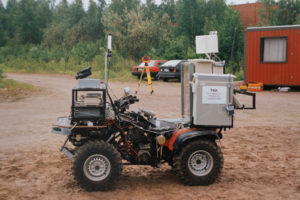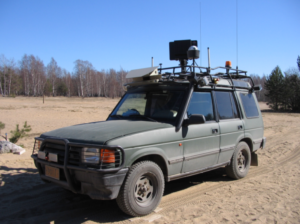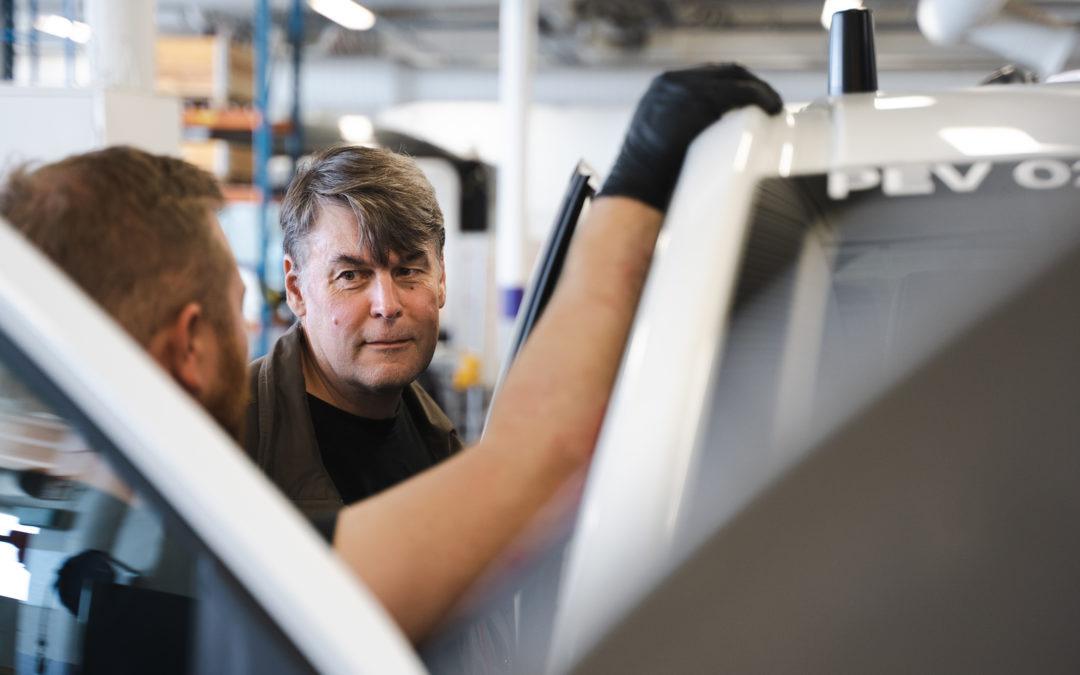I was looking at our latest autonomous vehicle – a retrofitted Toyota Proace – driving smoothly on the roads near our office in Espoo and started to think how long it took to come here.
Back in 1990 I was doing my M.Sc. studies at Helsinki University of Technology and started to work as an assistant in Automation Laboratory. Laboratory head professor Aarne Halme said that he has already seen process automation and traditional factory robotics therefore he focused the research on outdoor mobile robotics or “Field and Service Robotics”. His main point was that in factories we can always adapt to the environment for robots, but outdoors, the robots must adapt to the environment and the weather.
During my university time, the research was mainly focusing on mobile machinery since in Finland there are no automotive OEMs, but plenty of big machine manufacturers and industrial cooperation was always preferred to get finance for the research. However, the needed technologies for autonomous driving are the same, both off-road and on-road. A couple of self-driving cars were developed too during those years.
The main challenges were the same back then as what the industry is facing now in 2021.
- How to position robot accurately to follow a trajectory
- How to perceive and avoid obstacles
- How to make control, decisions, and planning based on limited information
The first prototypes
Our first testbed for autonomous driving was Arska Honda’s All-Terrain Vehicle (ATV) retrofitted for autonomous driving. Partially its technology was very near to our vehicles today. Vehicle location and movement was calculated based on odometry, steering angle, and Inertial Measurement Unit (IMU). To get the absolute position, we tested different technologies such as GPS, cameras, and tracking tachymeter. The performance was just quite different. In the ’90s the only GNSS available was GPS and there was artificial noise added to the signal thus the accuracy was ~100-200m instead of normal 20-40m. Our fibre-optic IMU was in fact as good as our today’s IMU, but we only had one for heading and the ones for other axes were quite poor. Obstacle detection was made with a self-made ultrasonic system, which was really bad compared to today’s commercial ones.

Picture: Honda ATV, Jussi Suomela
The first proper autonomous drives we did with a tracking tachymeter – the same device that surveyors use to measure locations, but with a capability to track a moving reflector. Our test vehicle had a cylindrical reflector in the back, the tachymeter followed the reflector, and measured its position with a few centimetres’ accuracy. Measured position was transferred to the vehicle. This allowed accurate route following in open areas with line-of-sight connection to the tachymeter. Arska’s computer Hardware was a state if the art office PC with real-time QNX operating system. The very first version of our existing OS – Linux – was published in 1991.
Cameras have been the eternal promise for autonomous driving: “Humans can get all needed information via their eyes, thus a camera should be enough”. Already at the end of the 1980s, some research projects presented cars following lane markings with cameras. Unfortunately, those cars were full of computers, which allow less computing power than mobile phones today. In our Arska ATV we couldn’t allow the size or price of computing power.
One step closer to autonomous driving in outdoor conditions
In 1995 an important technology for autonomous driving was presented. A rotating laser scanner. It was not yet capable of making 3D-images of surroundings like today’s LiDAR’s, but it was able to measure angles to reflectors located in the environment. The absolute position was calculated by matching the measured angles with the known positions of the reflectors. Again, we were one step closer to autonomous driving in outdoor conditions.
In the new millennium, the development was fast. Navigation and obstacle detection algorithms developed rapidly, when new generations of LiDAR sensors entered the market together with increasing computing power, making it possible to run both LiDAR and camera processing algorithms faster and faster.
We did a lot of projects and one, in particular, was for the Finnish defence force in 2004-2007. The objective was to develop a testbed for both teleoperation and autonomous driving. A Land Rover Defender was equipped with drive by wire actuators, high performance (and price) military grade six dimension IMU, cameras, LiDAR’s and radars. The system was tested in off road conditions and closed roads in the same years when Darpa organised it’s Grand Challenge series (2004, 2005) and urban challenge in 2007.

Picture: Autonomous Land Rover for the Finnish defence force
From University research group to startup
At the university, we started the Center of Excellence of Generic Intelligent Machines (CoE-GIM) by Finnish Academy 2008-2013. The research focused mainly on the autonomy of machinery producing with few interesting prototypes such as janitor robot WorkPartner, and intelligent worksite with semi-autonomous wheel loaders.
When the period of CoE-GIM ended in 2013 we had to make an exit plan. We founded the company GIM at the beginning of 2014. GIM continued the heritage of our academic work focusing on the automation of mobile machinery.
In 2016 we noticed that there was a French robot bus driving just a block from our office. My colleagues and I went for a test drive. It was raining slightly, not enough to open an umbrella, but the safety driver said that they can’t drive in the rain. We asked who is responsible for this robot bus pilot and contacted the guy to explain that robots can really drive during rain and snowfall too. This guy – Harri Santamala – was a little suspicious, but started to discuss with us and half a year later we founded Sensible 4 to develop autonomous driving software for last mile transportation in all weather conditions. Harri became the CEO. After 30 years of research, we were again developing autonomous vehicles.
Written by Jussi Suomela, CBO, Sensible 4
More reading

